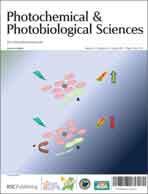Singlet molecular oxygen O2(1Δg) is a potent oxidant that can react with different biomolecules, including DNA, lipids and proteins. Many polycyclic aromatic hydrocarbons have been studied as O2(1Δg) chemical traps. Nevertheless, a suitable modification in the polycyclic aromatic ring must be made to increase the yield of O2(1Δg) chemical trapping. With this goal, an anthracene derivative, diethyl-3,3′-(9,10-anthracenediyl)bisacrylate (DADB), was obtained from the reaction of 9,10-dibromoanthracene and ethyl acrylate through the Heck coupling reaction. The coupling of ethyl acrylate with the anthracene ring produced a new lipophilic, esterified, fluorescent probe reactive toward O2(1Δg). This compound reacts with O2(1Δg) at a rate of kr = 1.69 × 106 M−1s−1 forming a stable endoperoxide (DADBO2), which was characterized by UV-Vis, fluorescence, HPLC/MS and 1H and 13C NMR techniques. The photophysical, photochemical and thermostability features of DADB were also evaluated. Furthermore, this compound has the potential for great application in biological systems because it is easily synthetized in large amount and generates specific endoperoxide (DADBO2), which can be easily detected by HPLC tandem mass spectrometry (HPLC/MS/MS).


 Please wait while we load your content...
Please wait while we load your content...